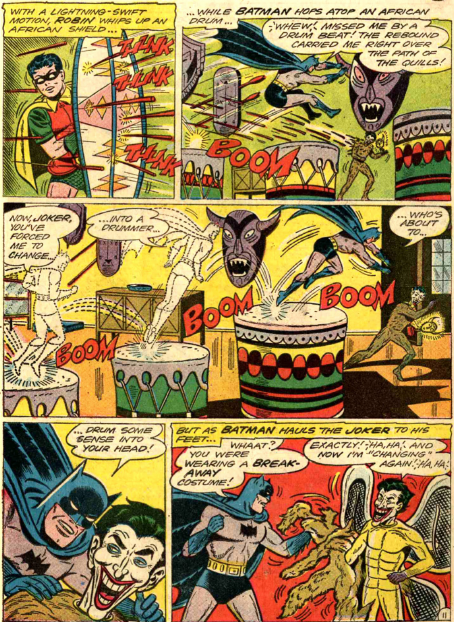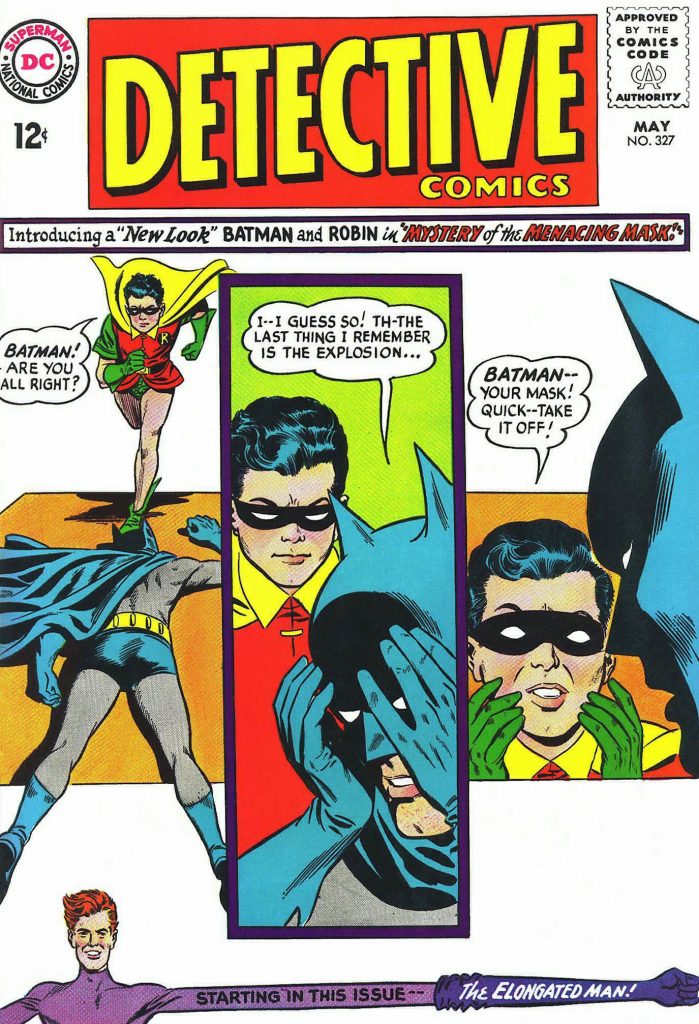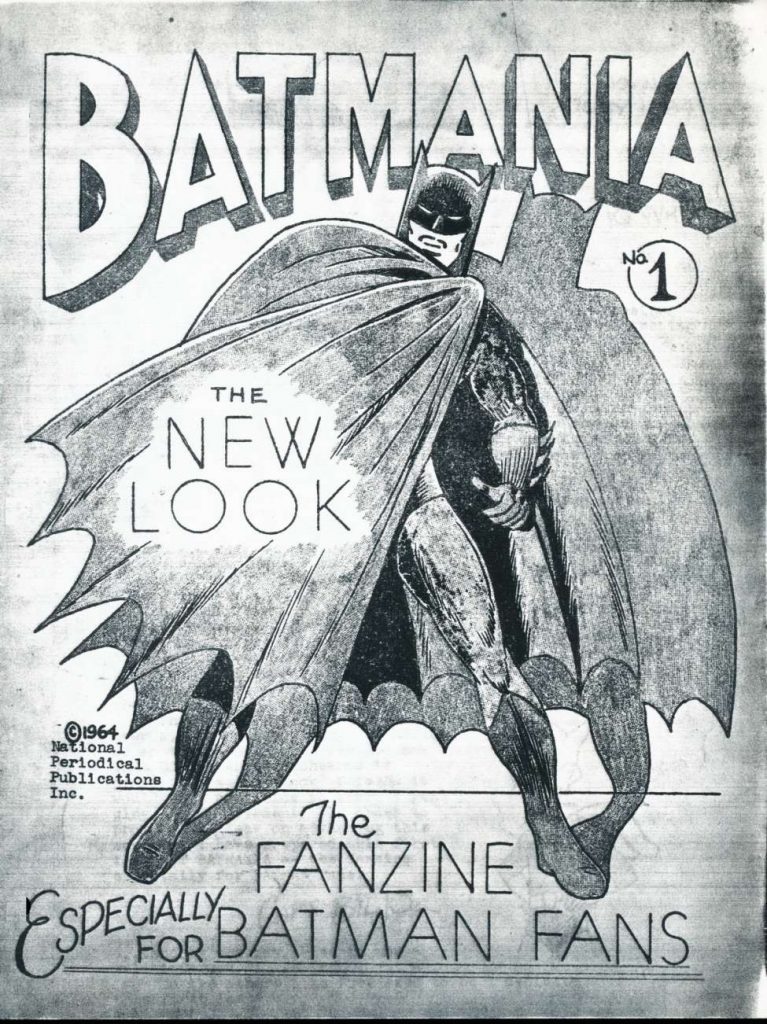
by Jason Sacks
Hello from sunny Seattle, where spring has sprung, the rain has (mostly) stopped, cherry blossoms are on the trees at the U-Dub, and Don & the Goodtimes are topping our city's pop charts.
My friends and I love hearing that wonderful local pop ditty on Kolorful KOL Radio while driving in his Corvair. Most often we wander down to the Spanish Castle, down in south King County (past my beloved Sicks' Stadium where the Seattle Angels play). At the Spanish Castle we get to watch some amazing pop, funk and jazz musicians deliver performances to warm us up on Seattle's rainy nights. Local standbys The Wailers, The Kingsmen and a very talented young man named Jimmy Hendrix have played there. Remember the name 'Hendrix'. According to rumors, he's keeping busy in England these days and may be working on a full album. My friends and I hope our local boy makes good.
But from one type of entertainment to another… It's been about a year since I talked in Galactic Journey about the state of American comic books. This seems like the perfect opportunity to give you an update on some changes I would never have expected.
In fact, before I dig into super-hero comics, I want to look at two genres of comics the fans seldom seem to notice: war comics and love comics. Yeah, neither genre has costumed heroes, but both are fascinating here in 1967.
Make War (Comics) No More?
National dominates war comics, while its closest competitor, Charlton, is frankly pathetic. Where is Marvel in the list? Well, Marvel still publishes Sgt. Fury and his Howling Commandos, but that comic has much to do with life in the army as Gomer Pyle, USMC does. Fury's style of goofy heroism may be a good read for the kiddies but it's too shallow for anyone over the age of 12. Anyone who is fascinated by the horrors and passions of war should read the good stuff.
Our Army at War is the flagship title of National's war comics line. This series stars Sgt. Rock and the combat-happy Joes of Easy Company. For several years now, writer Robert Kanigher has teamed up with the incredibly talented Joe Kubert to deliver some of the finest continuing-character war comics in my memory. Each story is like an opera of violence and martial situations with tight, terse prose matched by a gorgeously intense, slashy but stolid style by Kubert.
In fact, though I've seen Kubert's work for many years – he drew "Hawkman" in the Golden Age and drew the first Flash feature in Showcase, among hundreds of other stories – Kubert's style is hard to describe. Look at the below original page (from a friend's collection) to see what I'm trying to put into words.
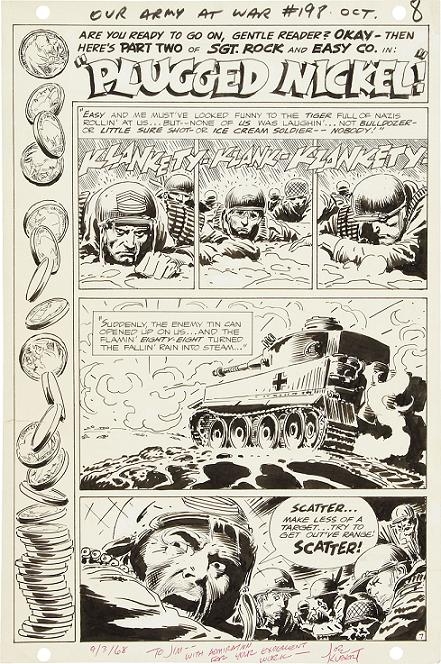
Look at the incredible storytelling by Kubert. The tumbling coins on the left add tension while the top three panels on the right show the misery, fear and determination in the eyes of the soldiers. Note, too, the clever way Kubert both divides and unifies the single image. That's a clever use of paradox to heighten the tension of the page. There's just nobody drawing comics like Kubert these days.
In fact, while many fans criticize DC/National frequently for having a house art style, their costumed hero books employ much more homogenization than their war titles . Perhaps Kubert deserves some of the credit for that, as he edits many of the titles.
To a lesser extent, we see Kubert's artistic approach to the other war comics National releases. For instance, Russ Heath is the main artist on the "Hunter's Hellcats" feature in Our Fighting Forces, and Heath brings a slightly more polished but equally visceral style to its art pages. Even old-timer Irv Novick brings a looser, more unconventional style to bear with his stories of "The Losers" in G.I. Combat.
More than anything, the DC war series feature a dark, despairing tone. Readers get a real sense of the horrors of war. Though Capt. Storm or Sgt. Rock may succeed in their missions, the battles obviously take their toll on the protagonists.
I wish the same could be said for the many war comics which quirky publisher Charlton Comics releases. I should talk more about Charlton in a future column. One thing I have to discuss is how their comics are published alongside song lyric mags, crossword puzzle magazines and cereal boxes, but that's a topic for another week.
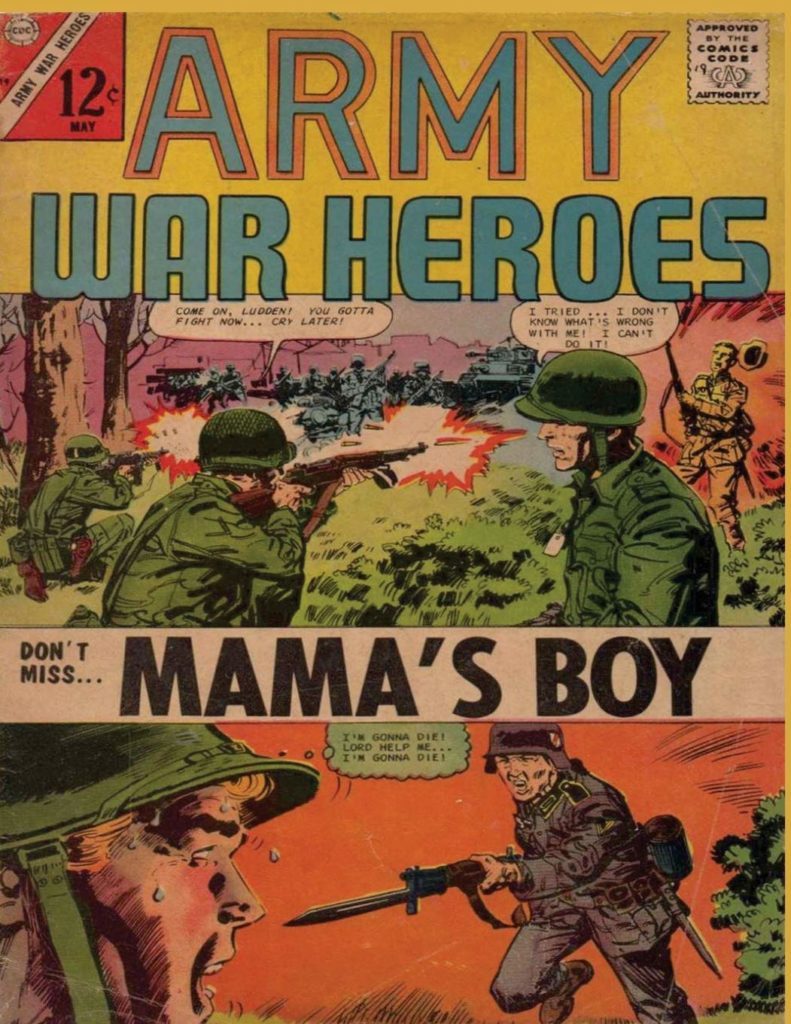
Instead, I'm here to bemoan Charlton's seemingly endless line of bland, dull war comics. Whether it's Fightin' Marines, Fightin' Army, Fightin' Navy (see a pattern?), War Heroes or Marine War Heroes, these chest-thumpin' men of action seem to never question their mission and never feel any pain from their incredible struggles. If you've ever wondered how the Pentagon would write comics intended for five-year-olds, read a Charlton war comic. I dare you.
While I'm discussing war comics, I should lament again the abrupt cancelation of Blazing Combat, Warren Publishing's often brilliant contribution to the war comics anthology genre. During its four-issue run last year, BC included sensational artwork by comics stalwarts such as Heath, Alex Toth, Gene Colan and many others. Writer Archie Goodwin told stories of wartime combat without filters, unnecessary heroism or national bias. With its ever-shifting anthology approach, Goodwin and his artists delivered stories which felt as contemporary as the Vietnam War and as timeless as the Peloponnesian War. Look, for instance, at the lovely page below drawn by the inimitable Reed Crandall.
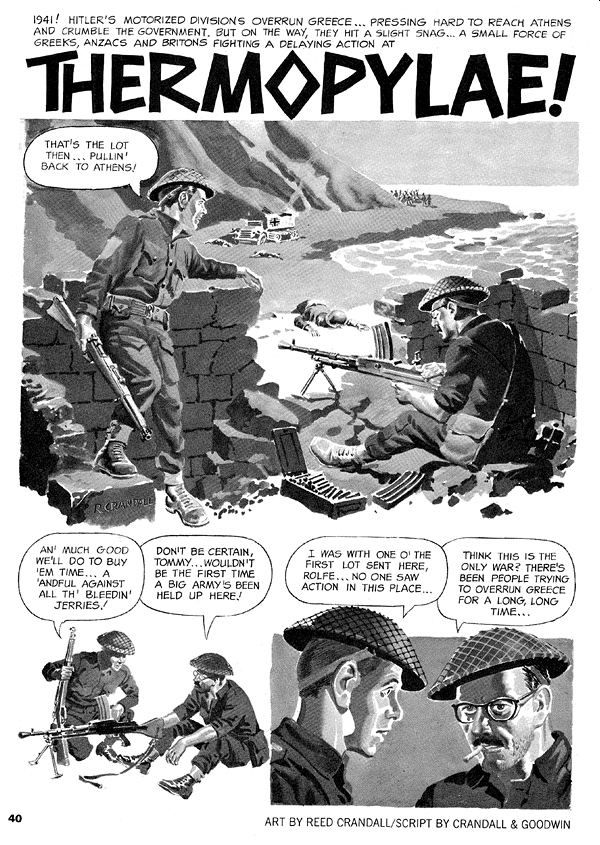
These comics were created in black and white, published magazine sized, and often illustrated with ink wash or pointillistic techniques. For those reasons, the stories in Blazing Combat aimed higher than most comic books. Indeed, their audience was mainly adults. Tragically, that selfsame adult audience spelled doom for Blazing Combat. Reportedly publisher Jim Warren had to pull the plug on BC when PX bases across the world canceled their orders after author Goodwin penned a story critical of the war in Vietnam. Sales were too poor to sustain a money loser for long.
Make Love (Comics) No More?
I wish I could praise the many, many love comics published by National or Charlton but I sadly can't. Hey, I'm a man who likes women, I'm fond of my wife, my sister and my mother, so why can't there be comics for women which don't insult their intelligence? Sadly, neither publisher seems able to pull off that skill. This is one area Marvel hasn't plunged into in 1967; probably good news for them. (Millie the Model is more an Archie-style humor comic than a love comic, by the way.)
Once again, Charlton leads the way with garbage, flooding the newsstand with interchangable junk like Career Girl Romances, I Love You, Just Married, Teen-Age Love, Sweethearts and many more. Like the sweethearts candies you got in your fourth grade class on Valentine's Day, these comics are laced with sweetness and may put you into a coma.
The love comics from National are marginally better, at least boasting work by professional cartoonists. But their attitudes seem stuck in the Eisenhower era.
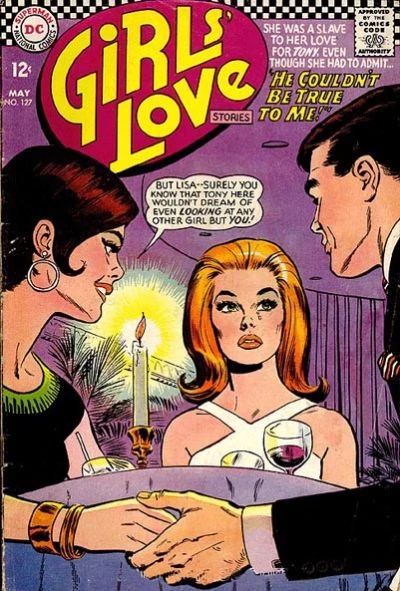
In fact, a reader should expect out-of-date attitudes. Comics like Girls' Love, Young Love and Falling in Love frequently feature reprints of comics from a decade earlier. Staff artists, modify the art to include modern hairdos or clothes. But their conformist attitudes reflect an earlier era when a girl's greatest goal was to be a housewife. It would be a bold statement for one of these comics to reflect the "free love" or hippie movements. The creators need to change with the time. Their musical beats should be attuned to the Beatles rather than Frank Sinatra.
I'd like to think there's a place for love comics in today's era. Perhaps some of the emerging group of so-called underground cartoonists can revive the genre, maybe with a twist. I know I would chortle to see a comic on the stands called Young Lust instead of Young Love.
Make Steve Ditko Comics at Marvel No More
Perhaps the biggest shock of the last year was the resignation of the brilliant Steve Ditko from Marvel Comics. Ditko, who was the prime force behind Spider-Man and Dr. Strange, apparently was engaged in a long, pitched battle with key Marvel editor/writer Stan Lee over the identity of a villain in the already-classic Master Planner saga. Ditko, who was the main plotter for the series, wanted to follow one direction for a character reveal. Lee disagreed and apparently that latest disagreement was the metaphorical last straw.
It's a shame because Ditko was reaching his apex on both series at the time this incident happened. Spider-Man was achieving new levels of bathos and power and was a solid, constantly interesting series.
Ditko's work on Dr. Strange, meanwhile, existed on a level few other comics have ever reached. In a vast, multi-chapter epic spanning some dozen issues, an increasingly desperate and isolated Strange journeys to lands scarcely imagined by mortal men. There, he encounters beings so unknowable and cosmically powered that their mere existence is beyond our mortal ken. Ditko set Strange as one single solitary man desperately trying to save our entire universe even while the rest of the universe continued on, blissfully unaware of the strange battles happening around them.
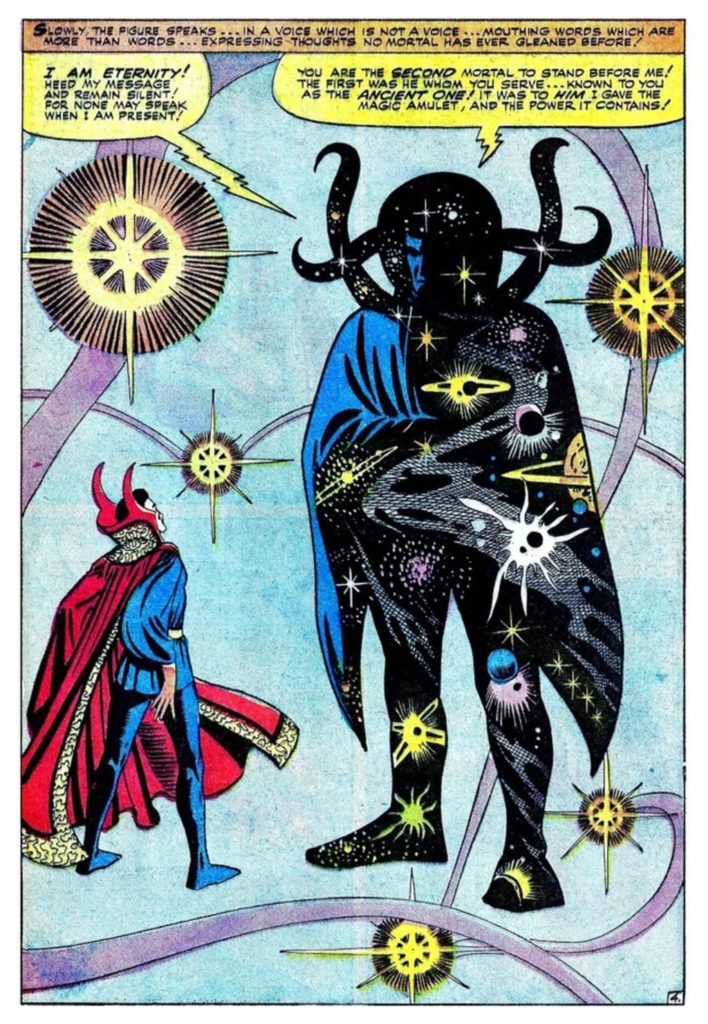
As you can see in the above excerpt, characters like Eternity live in great cosmic landscapes, full of bizarre and almost incomprehensible sparks which bespeak our insignficance as humans. And yet Strange, a mere human with expanded consciousness, fights desperately to avoid massive cosmic destruction.
That astounding storyline, a truly cosmic saga, drew the curtain on Ditko's Marvel era with a real sense of majesty.
The "Dr. Strange" strip has been drifting without Ditko's presence, with pointless stories and uninspired artwork. But I'm mention to you that Ditko's other great series, The Amazing Spider-Man, has reached new heights in 1967.
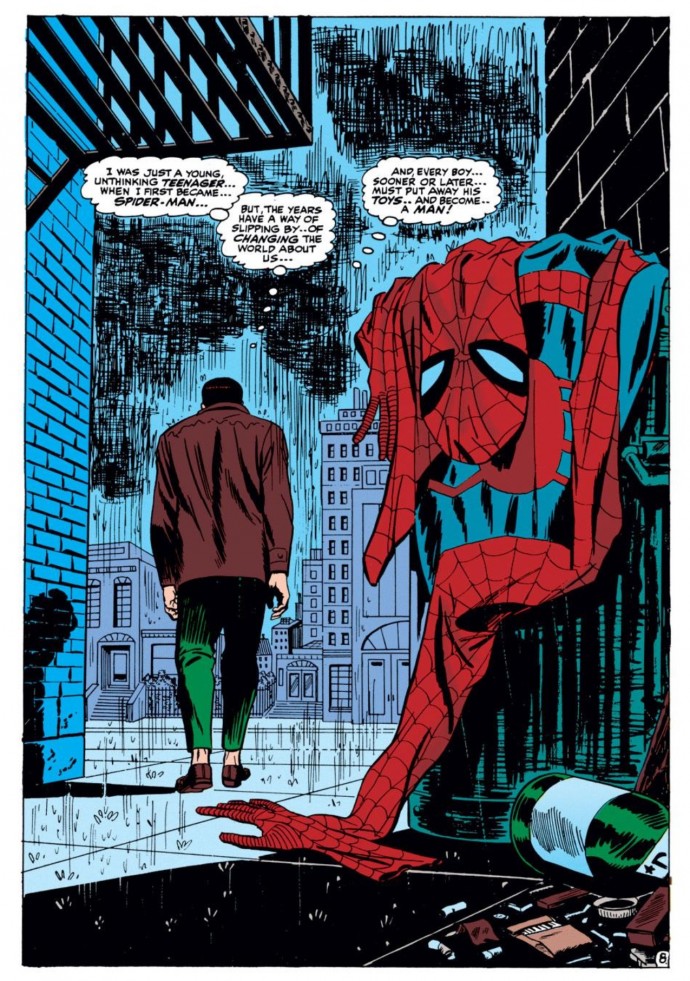
John Romita has stepped in to fill Ditko's shoes. Lo and behold, the impossible seems to have happened: the comic has gotten better. Amazing Spider-Man is now more fun, somehow both lighter and darker than before. More importantly, some charming supporting characters have emerged. I'm keeping my eye on Romita's groovy interpretation of Gwen Stacy. She seems like she could become a compelling love interest for poor ol' Peter Parker.
And the series seems to be finding its level. Amazing Spider-Man #50 was just released two weeks ago, so I don't want to ruin its fascinating twists and turns. But look at that wonderful page above and tell me you're not intrigued. Romits delivers drama Ditko couldn't reproduce in quite the same way and points to an exciting new future for the old web-head.
Jaunty Jim Debuts
Speaking of exciting futures, comic fandom has been buzzing over the last few months about the emergence of a new creator at Marvel who seems to have a unique set of skills. Jim Steranko is in a role unprecedented at Marvel, both writing and drawing the "Nick Fury, Agent of SHIELD" strip in Strange Tales. As far as I can remember, no Marvel creator has assumed the duties as writer and artist of an ongoing. His work is intriguing and unprecedented, and so far it's been spectacular.
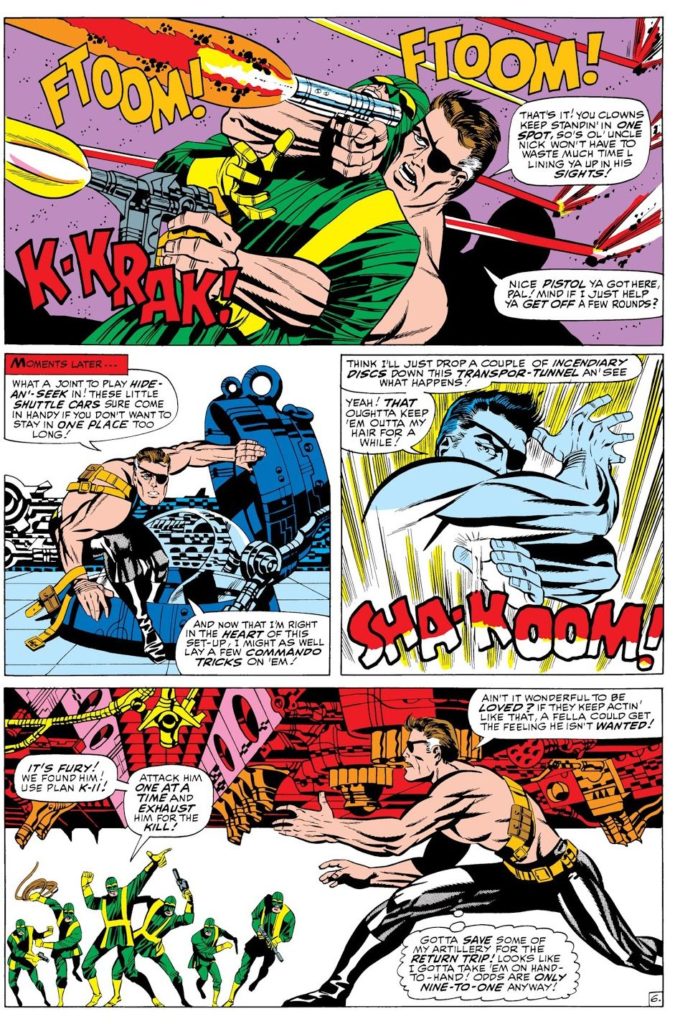
Steranko displays a dynamism and energy in his panels which rivals his mentor, Jack Kirby. His men seem coiled with power, drawn with dynamic foreshortening that holds tremendous power on the page even while the anatomy makes no sense in real life. In the page above, look at the wild energy of the final panel in the excerpt above, with its massive overwhelming machinery contrasting with the negative space to add power to Nick Fury's battle. Nobody, not even Kirby draws like Steranko. Who knows what the man can achieve in the coming years?
The King Remains and Reminds Us Why He's King
…which doesn't mean the King isn't carrying his own weight. Jack Kirby continues to deliver some ace action yarns in Fantastic Four and Thor. The recent Doctor Doom-Inhumans crossover story had me on the edge of my seat, as Doom schemed to assume the Silver Surfer's Power Cosmic and, with that power, control the world. That storyline was a deeply dynamic drama, definitively delineated by Kirby's crispy lines.
The Black Panther is perhaps the most dynamic character find of the last year. He debuted in the pages of Fantastic Four #52. T'Challa is the king of a futuristic kingdom deep in Africa who dons his ceremonial outfit to battle perfidious villainy, in this case embodied in the nefarious Klaw.

It's thrilling to see a Black hero appear at Marvel, especially one who can defeat our estimable heroes in battle while maintaining his regal presence. I'm so intrigued by this new hero. I hope he returns soon. I can't wait to read more about him. (Seems to me he'd be a great member of the Avengers.)
And as for Thor, if there ever was a case where a picture says a thousand words, the below image does that!
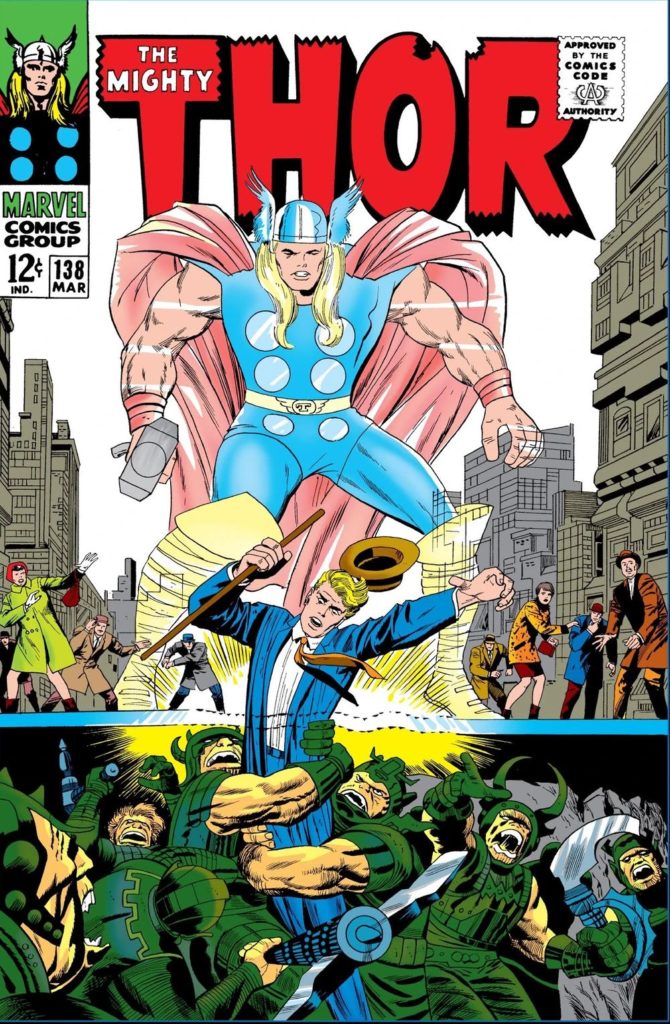
If you don't want to read that issue of Thor, you clearly lack an imagination!
The Debut of Batgirl
Life at National Comics has been a little quieter than life at Marvel these days. Their quietness has started to make National's line of heroes feel a bit stodgy compared with their Marvel counterparts. Lately the Justice League of America has veered a bit into camp, which felt appropriate when the Batman TV series was at the top of the charts. Since people are starting to get bored of Batman's repeating jokes, likely sales of Batman-related comics will begin to sag as well.
For instance, the return of the Penguin to comics in Batman #190 boasts a wonderful cover by Carmine Infantino but… darn, look at the stiff and uninspired artwork inside the issue.
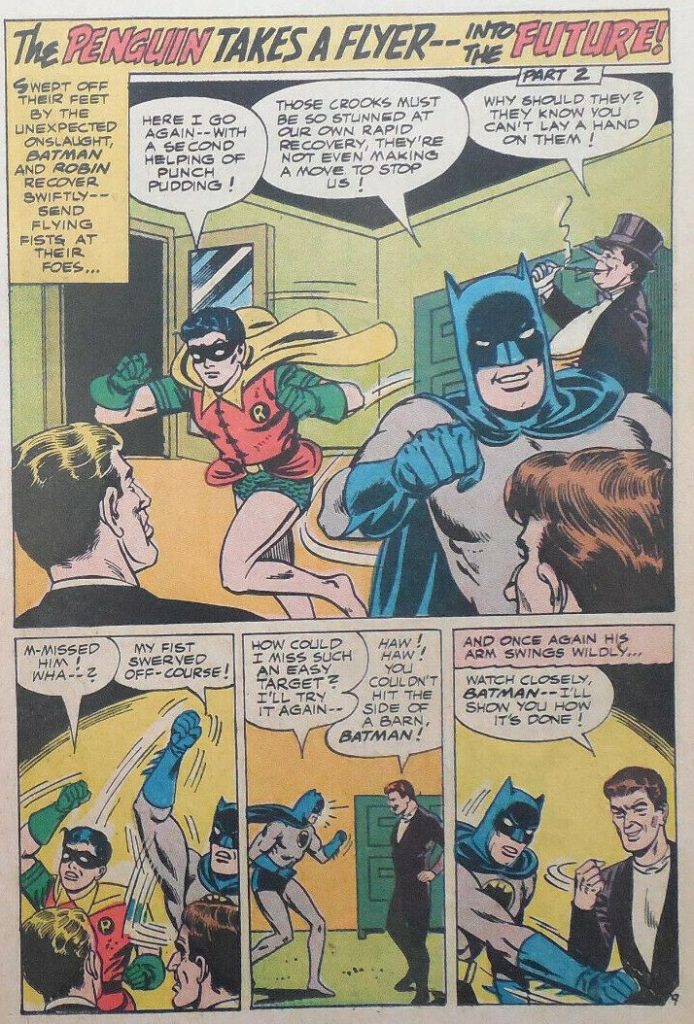
Maybe the introduction of the dynamic new Batgirl will revitalize the Batman comics a bit. College student Barbara Gordon, the daughter of Commissioner Gordon, donned her distaff version of the cape and cowl in Detective Comics #359, late last year. Fan reaction to her appearance has been all over the place. Many have praised the idea that this new Batgirl can actually throw punches and kick some heads in – unlike the more old-fashioned Bat-Girl of the 1950s. Others have complained about the need to tie Commissioner Gordon more closely with our heroes. And some younger fans have complained about Batgirl acting like a big sister to Robin, which embarasses him since a girl can often out-achieve him (of course the female fans love that aspect of the heroine).

Under Infantino's pencils, the new Batgirl is a lilthe, athletic fighting machine. She's also kind of a women's libber, fighting with the ability of a man while maintaining her female identity. She would be a welcome addition to the Batman TV series. I hope she gets added to it soon.
Sadly, unless her series takes a radical turn, I can't imagine Wonder Woman becoming a feminist icon. I dare you to look at the cover below and tell me I'm wrong.
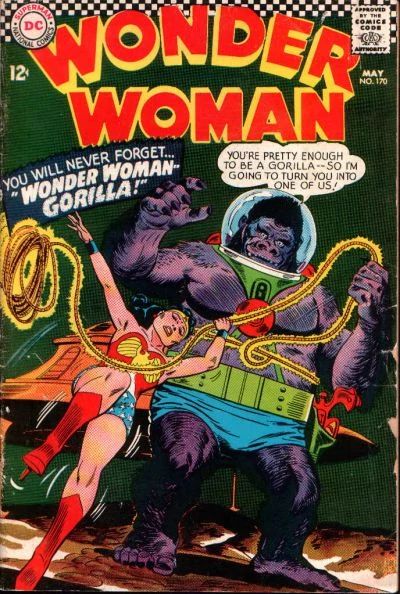
The tremendously prolific Robert Kanigher writes Wonder Woman. He's is one of the key forces behind the war comics I mentioned earlier. Maybe's he's too busy in his mental combat to consider the abuse he's heaping on his heroes.
In fact, of DC's heroes line, only "Legion of Super-Heroes" in Adventure Comics resonantes for me (well, okay, one other series has sparked excitement – see below for the details). My newfound love for the Legion surprises me. I usually yawn at the Superman family of titles (which this is part of). Readers get one variation after another of the same full stories. But new writer Jim Shooter has brought a new energy to the future's finest super-teens. Just this year, "The Doomed Legionnaire" brought an unexpected death to the team (I promise I won't tell you who dies!) This month, we're viewing an incredible flash-forward to a time when the Legionnaires are adults. It's spellbinding stuff, written for teenagers with an energy and freshness which makes me wonder if Shooter himself is a teen.
And finally…
This article has aleady run long, so I'd better add a few final notes before I head down to the Spanish Castle to see Paul Revere and the Raiders…
- Doom Patrol continues to be DC's ginchiest comic book – miss it and weep, pals!
- Archie's super-hero parodies like Captain Pureheart are a giggle a minute if you're in the right mindset. They are well worth your twelve pennies.
- Warren continues to publish the outstanding horror comics Creepy and Eerie, and each feature work by the delightful Mr. Ditko. Miss them at your peril.
- Look for copies of King Comics' Flash Gordon on your local stands. If you can find it, you will find some breathtaking comic art by the likes of Al Williamson and Reed Crandall.
- And lastly and leastly, a reminder that the weakest and dullest comics in the Marvel line is The X-Men. Save your cents for its much better imitator, Doom Patrol. When will Marvel wise up and give up on this series?
Till next time, sayonara!

![[April 22, 1967] Make War Not Love (Comics)](https://galacticjourney.org/wp-content/uploads/2022/04/thor138-672x372.jpg)

![[October 22, 1964] Introducing a "New Look" for Batman](https://galacticjourney.org/wp-content/uploads/2019/10/batman-cover-672x372.jpg)


